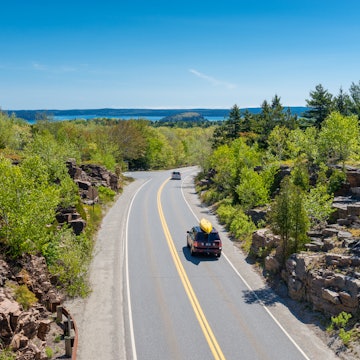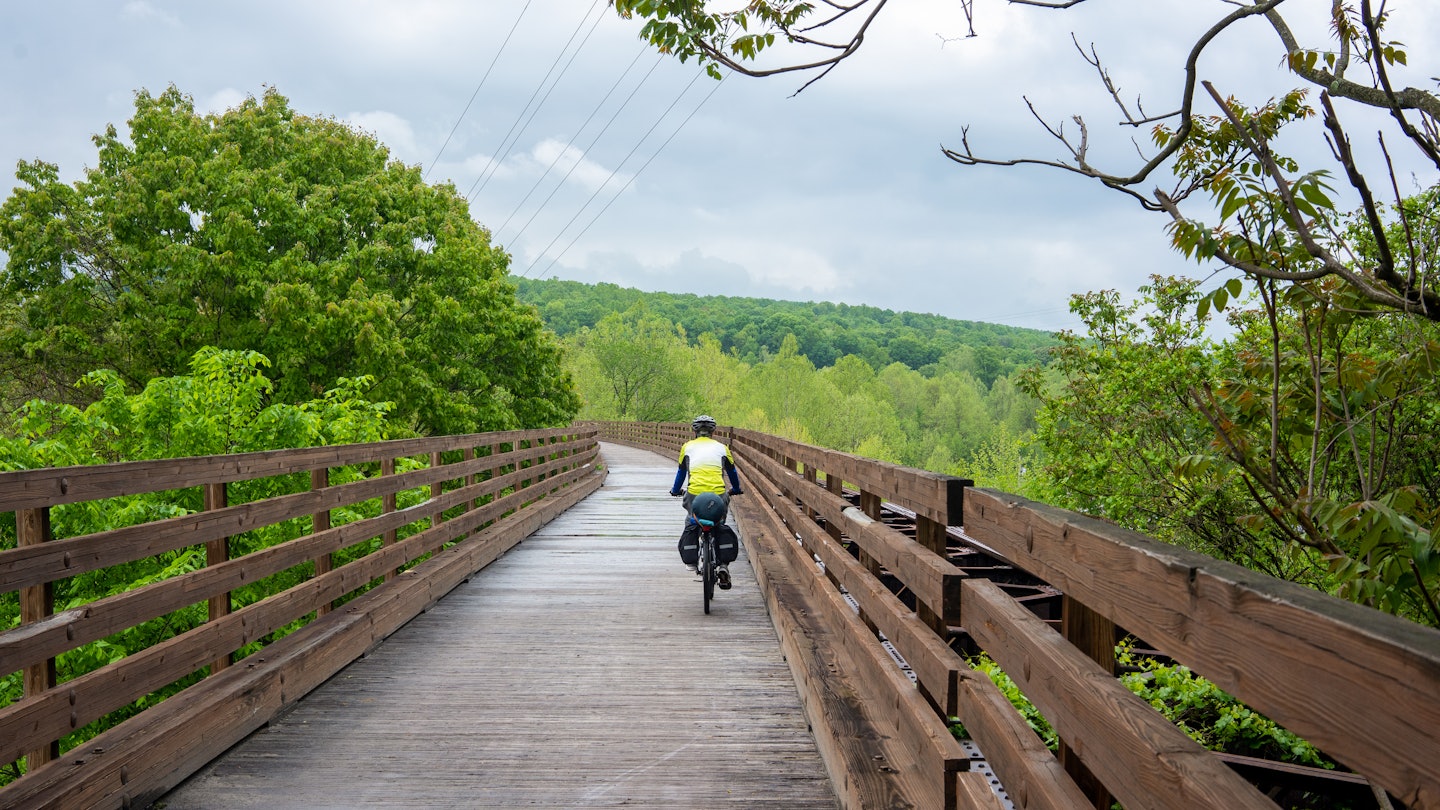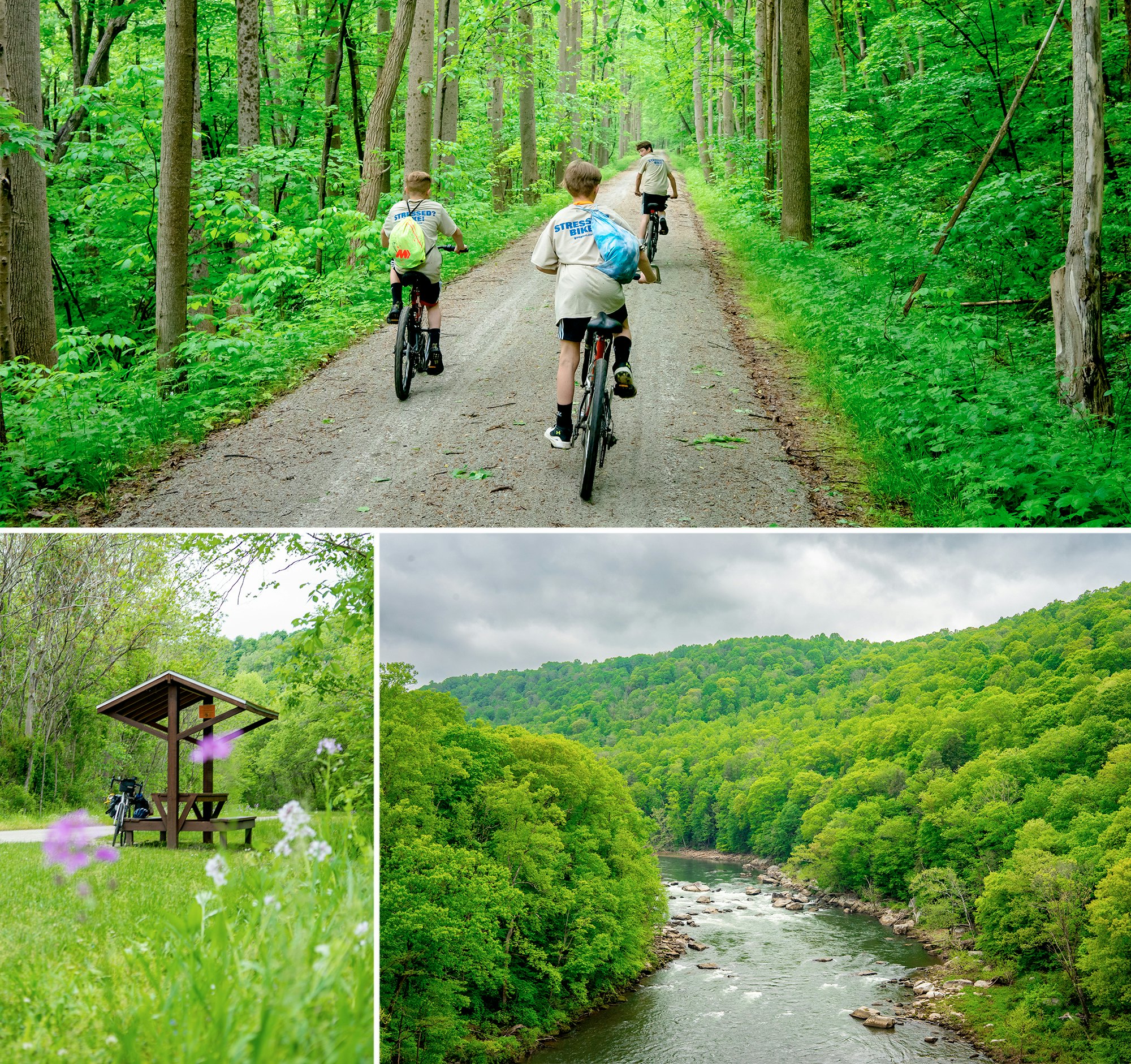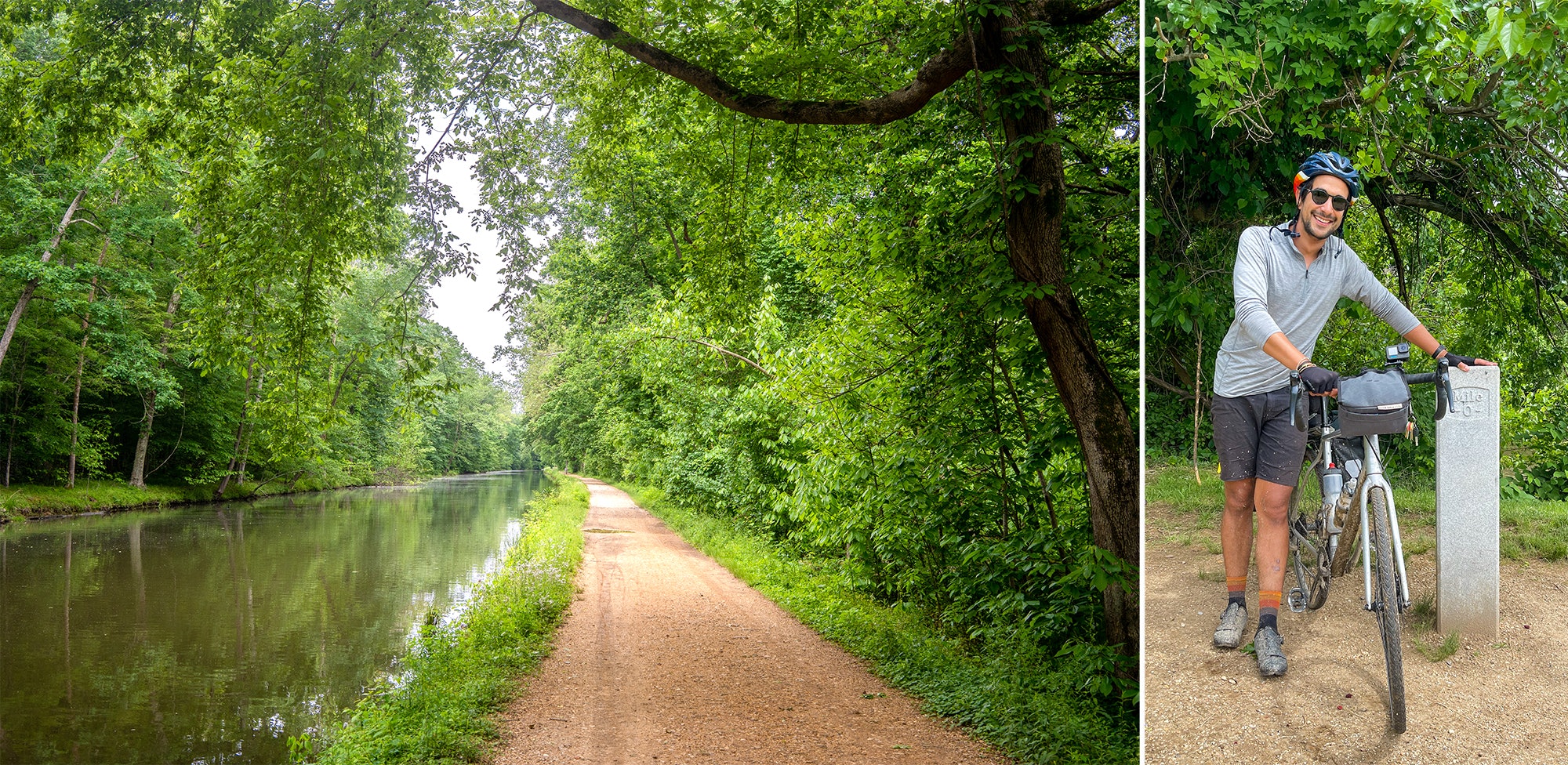
Finding a different tempo on a bike ride from Pittsburgh to Washington, DC

Jul 28, 2022 • 16 min read

The Great Allegheny Passage (pictured) and the C&O Canal Towpath allow adventurers to ride between two major American cities, with barely any time spent on roads with cars © Sebastian Modak / Lonely Planet
On a 335-mile journey along the Great Allegheny Passage and the C&O Canal Towpath, editor-at-large Sebastian Modak found there was much to learn by hitting the brakes.
I rolled into Cumberland, Maryland, with the distinct impression that I should be celebrating, but also the creeping feeling that I was about to give up. For the past three days, I had been traveling by bicycle on a journey from Pittsburgh to Washington, DC, and this was the halfway point…sort of. It was the halfway point because it was where one trail, the Great Allegheny Passage, ended and another, the Chesapeake and Ohio Canal Towpath, began. It was not actually halfway – my brain reminded me – because I had only traversed 150 miles of smooth, crushed limestone trails, which left about 185 miles of dirt and mud to go.
This was something I could scarcely believe existed when I first heard of it: a virtually car-free bicycle route running a full 335 miles between two major American cities. Infrastructure for the sake of nothing but non-motorized recreation? A gorgeous, winding bike trail with regular water pumps, bike repair stations and plenty of access to nearby towns, where hotels and cafes catered to cyclists and hikers? Here, in the land of highways and drive-thrus? It sounded almost Scandinavian.

The Great Allegheny Passage – a rail trail extending from Pittsburgh, through the lush Laurel Highlands, to Cumberland – was supposed to be the most carefree part of the trip. From there, the C&O Canal Towpath, where mules used to pull barges along the waterway, would bring me over rougher terrain all the way into DC. The overall route was flatter than most. I had packed camping gear with me for the second half of the trip, but stayed, until that point, in comfortable B&Bs where I could end each day with the twin luxuries of a cold beer and a hot shower. This was, in other words, supposed to be easy.
Sitting alone on a Cumberland park bench as the temperature crept up towards triple digits Fahrenheit, I looked up the schedule for trains home. A combination of factors had brought me to this point. There was the bad weather: a meteorological game of tag between tree-felling thunderstorms and soul-crushing heat. There was the motivation: even with regular checkpoints to mark your progress, this sort of trip is easier with company than as a solo adventure. And then there were my knees: long taken for granted and now moving with all the fluidity and ease of two ancient millstones.
@lonelyplanet "Once I slowed down enough to notice all the details around me, I really started enjoying the trip and appreciating how special it was to see this part of the country from a bicycle," says our editor-at-large @sebmodak.
♬ Sunny and Happy (Upbeat Background Acoustic) - loop version - FishSongs
It wasn't supposed to be like this. I had planned to meet an old friend in Pittsburgh two weeks earlier and cycle together, but those plans were upended – like so many other things – by COVID-19. After I tested positive on the eve of the trip, I had to cancel. When I tested negative after two weeks of sickness and isolation, I took it as a green light and rode my bike to New York’s Penn Station for a train to Pittsburgh.
Under the pressure of work deadlines and antsy after so much time in bed, I had approached the trip with a misplaced desire to prove something to myself. Pain was meant to be ignored and pushed through. Hardship was part of recovery. Goals were supposed to be difficult to reach.
On Québec’s Route Verte, not knowing what I was getting myself into was the best part

But now, in Cumberland, my body was saying it wasn’t ready for this yet. How was I going to get to Washington, DC in two and a half days as I had planned? I wasn’t, I realized as despair began to set in, before another thought crept into my mind, shocking in its simplicity. Indeed, I wasn’t going to get to DC in two and a half days…and that was okay. I’m not sure when I had started treating this trip like a race, but releasing the desire to “win” was freeing. I decided I was going to give myself a day off, here in Cumberland, which I’d spend mostly horizontal, ice on my knees, before continuing on with no real plan and no self-imposed checkpoints. I’ll get there when I get there.
9 best long-distance bike rides around the world for 2022
Architectural marvels and tunnels of trees
By the time I hit Cumberland, the first stretch of the trip on the Great Allegheny Passage (GAP) had already turned into a blur, where days bled into each other and mental milestones were bookmarked by thunderstorms.

The GAP starts (or ends, depending on your perspective) at Point State Park in Pittsburgh, at the confluence of the Ohio, Allegheny and Monongahela Rivers. By the time I got to the starting line on the first day, it was lunchtime. Having arrived by train, late at night the day before, I enjoyed a slow morning in Pittsburgh. I spent a good 30 minutes chatting to Mary Beth Karabinos and Paul Kletter, co-owners of Traveler’s Rest, a comfortable, understated, hostel-inspired guesthouse catering to cyclists in the city’s South Side neighborhood. From there, I made my way to Bicycle Heaven, the largest bicycle museum in the world. Thousands of bikes spanning decades fill multiple floors of garishly lit, hallucinogenic rooms. For 20 minutes, I wandered aimlessly through a universe of spokes, handlebars and bicycle-themed tchotchkes. I left with a smile on my face.
By the time I found the beginning of the GAP, a light drizzle had started, and I was about three hours behind schedule. Sixty miles to Connellsville. It was time to ride.
10 best places for a cycling vacation in 2022

If the first day had, due to my sluggish start, forced me into a race against sunlight, the second was saved by a detour. The section of the GAP that runs through Ohiopyle State Park in southwestern Pennsylvania is arguably the most beautiful stretch of the entire Pittsburgh-DC gauntlet. Suspended over a steep gorge, the trail crosses bridges and frequently leads to lookout points, where a break in the thick summer foliage reveals the rushing Youghiogheny River. The town of Ohiopyle – a haven for whitewater rafters, kayakers, and hikers – sits on a particularly kinetic bend of the river. And a couple miles north of town, up a steep winding road, is an architectural wonder.
Fallingwater is technically reachable by bike, but it is not recommended, as the road is steep and frequented by trucks. So I left my bicycle parked at the headquarters of Wilderness Voyageurs, an outdoors tour operator that offers shuttles to and from town. Hidden away in the woods of Bear Run Nature Reserve, Fallingwater might be the first piece of modern architecture that has given me the punch-in-the-gut feeling of awe usually reserved for nature. And that’s kind of the point.
A new cycle route will take you from Yellowstone to Minneapolis

The architect Frank Lloyd Wright believed in what he called “organic architecture,” where the delineation between what we build and where it’s built is porous. In the case of Fallingwater – often touted as the prime example of this philosophy — that means a cantilevered concrete marvel suspended over a rushing waterfall. Completed in 1938 for the Kaufmann family, the building is now run by the Western Pennsylvania Conservancy, a private nonprofit that runs tours of the space. The sound of rushing water and birdsong is continuous, no matter if you are outside or inside. Little details only surface on a tour: the stacked floor-to-ceiling bedroom windows, which the Kaufmanns could use to adjust how loud the running water would be as they fell asleep; the wooden shelves, cantilevered simulacra of the building itself and the surrounding rocky ledges; the uniform ochre and red color scheme. By the time I left, taking the short shuttle back down the hill to the town of Ohiopyle to get back on the bike, it felt like I had never really left the woods at all.
That should have been my cue to slow down, but having made the mistake of booking accommodation too far in advance, I kept pushing myself. From Ohiopyle, I rode on to Confluence. And from Confluence, despite waking up to pouring rain and re-inflamed, aching post-COVID knees, I rode 55 miles past the Mason-Dixon Line, up to the Eastern Continental Divide, and down into Cumberland.
A mountain biker shares how Nordic Europe combines the best of food and biking
More than history
Cumberland, Maryland, is a place with echoes of importance. Today, it’s a small town – population 19,500 – where it can be hard to find a meal after 9 pm, but it doesn’t take long to realize that, tucked into a valley at the terminus of the canal and at the intersection of two rivers, this place was once a really big deal. Big brick buildings, the faded harbingers of American industrialization, still line the streets. In a tiny, one-room museum, the walls are covered with old train timetables and paintings of steam engines pulling into downtown Cumberland, heaving with coal and iron ore bound for the capital and beyond.
Over 500 miles of new bike trails are now open to cyclists in the US

For a few years in the 19th century, Cumberland sat at the crux of competing technologies – a liminal space between the ages. It’s hard to imagine now, but at one time, the most efficient way to transport goods through dense woodland was a canal and a towpath. Mules would be hitched to a boat and, plodding along dirt trails parallel to the waterway, pull goods. By the time the C&O Canal had reached Cumberland in 1850, however, the Baltimore & Ohio Railroad had been functioning for eight years. Though the canal continued in operation in some capacity for another 74 years, it was already obsolete by the time it opened.
Before I left on the trip, I had spoken to someone who had told me that, while the nature was beautiful, the small towns were part of what made this route so appealing. Bekah Zook now works as the tours operations manager for the Montana-based Adventure Cycling Association, a nonprofit devoted to bicycle touring, but she grew up in the region covered by the GAP and C&O trails. She estimates that she’s done the route between 50 and 60 times over the years.
“Having this corridor between these two really large urban areas that is so quiet and so secluded really forces you to focus on the smaller communities that exist between the big metropolitan areas,” Zook said. “These are places that a lot of people don’t know about, so this ride really gives you the space to visit them in a really unique way.”
Award-winning Belgian bike trail propels cyclists above an adventure forest

In town after town, on both the GAP and the C&O, I saw vestiges of a grandiose past and an uncertain future. When I’d see empty streets and boarded-up houses, it was hard to imagine that the towns stretching east of Pittsburgh and west of DC used to be the industrial aorta of this country – a manufacturing powerhouse that created some of the world’s first billionaires. Then I’d pass an abandoned factory or a row of mansions grown over with ivy, and it would make sense.
As a brown man, at times, it was impossible to ignore the fearful whisper that accompanies any person of color traveling in certain sparsely populated corners of the country. I saw enough Confederate flags in certain neighborhoods to make me reconsider stopping for lunch. When I walked into a diner in Paw Paw, West Virginia, I could almost hear the record scratch, as conversation ceased and a dozen heads turned towards me. I ordered a grilled cheese to go.
The UK's longest mountain bike trail for beginners is now open

But besides the occasional discomfort, the ride through the small towns that line both trails was an education and a delight. In the idyllic community of Confluence, Pennsylvania, I stood in the middle of the road and spoke to an elderly man named Jimbo for 45 minutes. My new friend, seemingly unconcerned that the whole pizza I was carrying back to my B&B was rapidly getting cold, told me what it was like to grow up in this town when the population was twice as large and “every day someone was having a party.” As I was getting into bed, the doorbell of the Smith House Inn rang. Jimbo was wondering if I wanted him to show me around the next morning before my ride, an offer I couldn’t take up; I had a schedule to keep.
In Hancock, Maryland, I took up a position on the vast deck of Buddylou’s Eats, Drinks, and Antiques and watched as families joked and laughed the afternoon away; one toddler offered me his half-eaten ice cream, which I respectfully declined.
This English traveler ordered a new bike from China - and flew there to cycle home

In Brunswick, Maryland, I found shelter from the rain at Beans in the Belfry, a church that has been converted into the kind of cozy cafe that appears to have been built for rainy days. By then, I had accepted my new take-it-slow approach to the trip, so I ordered a slice of pie, pulled out a book and waited for the rain to die down. In Harper’s Ferry, West Virginia, I sipped cocktails at Snallygaster’s, an old-timey general store converted into a wine bar.
Perhaps most importantly each new town was different. It’s true that Steel Country had once been shinier and the coal mines had once been treasure troves. It’s true that there are people who are struggling, having been left behind by a shift in global manufacturing. But seeing these places at the speed of a bicycle was the reminder I needed that, like anywhere, they are places with a future tense, too.
Walk or cycle from NYC to Canada on the new Empire State Trail

Just as I had spent long hours on this trip overlooking the beauty around me, this was a cut of the country that seemed to be perpetually overlooked by, well, everyone. Or mostly everyone.
Kletter and Karabinos of Traveler’s Rest, who told me they wouldn’t have opened the hotel in Pittsburgh if not for the GAP Trail, also told me they have had guests from as far away as Japan and New Zealand, flying halfway across the world to ride the GAP and C&O.
“I hear from a lot of people that this is a world-class trail, and I do agree because it has the amenities to support many forms of travel,” Kletter said, pointing to accommodation options that range from $200/night luxury B&Bs to free campsites. “I really think that it captures a true representation of this part of America: these old steel and coal towns that are now in the middle of being reborn in some way, partially thanks to tourism.”
In Iceland’s remote Westfjords region, a new bicycle route takes shape
A new approach, a new pace
The C&O towpath is a National Historic Park administered by the National Park Service and as such, unlike the Great Allegheny Passage which was completed in 2013, it looks much like it did when it was first built centuries ago. After days of rain, the path had turned into thick mud and sections felt like riding through peanut butter. On my first day back on the trail after resting in Cumberland, forecasts remained in hellscape territory, but I rarely felt the urge to move faster than 10 miles per hour.

Every few miles the tunnel of green would lead to an old canal lock, where water flow was once regulated and canal boats were lifted and lowered to new elevations. Sometimes, there would be lockhouses too, wooden structures from a time long past, where the lockkeeper and their family would live and work, waking up at odd hours when a boat might pass through. (Today, you can spend the night at some of the lockhouses that have been outfitted to conjure different periods through the canal’s history.)
While I had sped by most of the informational plaques along the Great Allegheny Passage, spurred on by some deranged urge for the trip to be over, along the towpath, I stopped to read them. There is more history in these lands than just industrial booms and busts. I rolled past Civil War battlefields, routes that once intersected with the Underground Railroad and lands that, long before the arrival of European settlers, had been home to a patchwork of Native American societies who lived off the bounty of the Potomac.
Florida's iconic 100-year-old Seven Mile Bridge reopens to cyclists and walkers

Slowing down allowed small details to emerge into the foreground. The reverberant drumroll of a woodpecker’s beak hitting bark. The languid, satisfying plop of a turtle dropping into the canal’s waters, breaking through the algae that covered the stagnant water like a neon-green sheet. Each morning, I noticed how everything around me glistened under a thin layer of morning dew. Each evening, after a day of slow and steady cycling, I stopped to watch the first stars appear as the frogs began to croak.
I had originally outlined a five-day trip between Pittsburgh and DC. The day off in Cumberland shot that – refreshingly – to pieces. Once I got rid of the time limit, other opportunities for diversion revealed themselves. The C&O’s regularly spaced, free hiker-biker campsites made going with the flow extra easy.
By the time I woke up in my tent, ready for the final stretch into Georgetown, I had been on the trip for a full week. My knees still hurt, my clothes had been soaked through and dried again at least four times, and my bike was making some worrying noises every time it hit one of the frequent bumps on the towpath.

Rolling back out onto the trail, a pair of cardinals chased each other in circles above me. Flowers peeked out from behind the wild tangle of weeds lining my way forward. The heat had dissipated and even the forest seemed to be sighing in relief. I was thankful to be moving slow enough to notice.
Explore 5 US states by bike with these newly designated routes
Make it happen
Getting there:
If you’re within train distance of either terminus, you don’t need a car to make this trip happen (bonus points for sustainability!) I took Amtrak from New York, where I live, to Pittsburgh to start my trip, and from Washington, DC back to New York. Both routes allow bicycles onboard – just make sure to reserve (and pay for) a bike spot in advance, when you buy your ticket.
Choosing a bike:
Despite some bumpy roads along the way, you don’t need a mountain bike to complete the trip. That said, you’ll be most comfortable with something that has tires at least 35mm wide, especially for the C&O, which can get pretty rough, especially after it rains.
Finding the latest intel:
Speaking of rain, the C&O, being unpaved, is very susceptible to wash-outs, landslides, and construction work, which means there are frequent closures of certain sections of the trail, requiring detours. Check the National Park Service’s website for up-to-date information.
Getting some help:
If you don’t want to bring your own bike (or carry your own stuff), you have options! A number of tourism outfitters offer guided rides of the GAP and C&O. Others offer shuttle services, luggage transport, and bike rentals. A lot of trail veterans I met recommended Golden Triangle Bike in Pittsburgh. Woman Tours organizes supported all-women bike tours, including on the GAP and C&O. I ran into one of their groups repeatedly on the trail, and was envious of their cushy set-up.
How Slovenia is taking the lead as a top cycling destination in Europe













